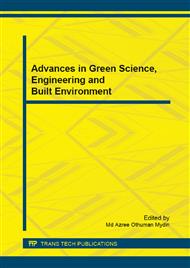p.60
p.64
p.68
p.72
p.76
p.80
p.84
p.88
p.93
Unique Elements of the Traditional and Vernacular Masjids in Malaysia; Traditional Elements Acquainting Practical Sustainability
Abstract:
Since indigenous construction, sustainability had appeared into practice though it was not performed in high technology manner. The paper focuses on the traditional masjids in Malaysia where traditional technology of passive design has long been inculcated. Passive design strategies which are practical are ablution from rain water harvesting, comfortable interior without mechanical ventilation and flexible layout with future expansion, employment of materials suitable to the climate and simple device of roofing system that gives major contribution to the indoor space quality. The paper reveals that practical sustainability features used by the former generations suggest great contributions to the future of architecture and construction without inflating the cost. Three masjids are chosen to be case studies and they are examined and observed in order to conform on the performance of practical sustainability
Info:
Periodical:
Pages:
76-79
Citation:
Online since:
March 2015
Authors:
Keywords:
Price:
Сopyright:
© 2015 Trans Tech Publications Ltd. All Rights Reserved
Share:
Citation:


